A brief history of the Norwich Philharmonic Society
(Written to mark the 150th Anniversary of the Norwich Philharmonic Society in 1991)Neville Miller puts today's Philharmonic Society into its historical context.When the Norwich Philharmonic Society made its public debut on March 5th 1841 Queen Victoria was 21 years old and the mother of a three-month-old daughter. In November that year she was to give birth to a son who became King Edward VII and, as Prince of Wales, bought SanDringham Estate in Norfolk. Royal happenings - the marriage to Prince Albert in 1840 and the first child - would have gladdened Norfolk hearts, but there was another sensation on the horizon that promised to have a more immediate effect on their lives. They were seeing the dawn of the railway age. 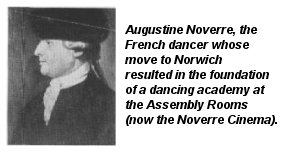 Within a week of the Philharmonic Society's debut, the Norwich Mercury carried advertisements giving notice of application to Parliament for bills that would permit the tracks and buildings of railways in the Norwich area. But in 1841 travel was primitive, Norfolk was a long way from elsewhere and its music was made by home musicians. One of the city's most active supporters of the arts and the one whose energy and enthusiasm was to bring about the founding of the Norwich Philharmonic Society was Frank Noverre. He was the grandson of a French dancer, Augustine Noverre. In 1775 Augustine came to England with a corps de ballet at the invitation of David Garrick, one of England's greatest actors, who at that time was also manager of the Drury Lane theatre where the dancers were to appear. 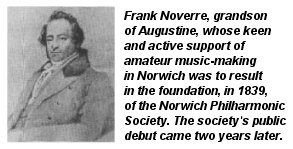
This was just before the outbreak of war with France, and during an anti-French riot Augustine injured one of the demonstrators with his sword. It was not a mortal wound but this, and the general unrest in the capital, was enough to show Augustine the wisdom of getting out. Perhaps he came to Norwich because there were already French spinners and weavers in the city who had fled from religious persecution. When the disturbances had died down he returned to London and became a member of the corps de ballet at Drury Lane. Retiring from the stage he settled in Norwich and set up a dancing academy at the Assembly Rooms. This was inherited and expanded by grandson Frank. A man of wide artistic sympathies, Frank was treasurer of the Norwich Choral Society and one of the keenest supporters of the Norwich Triennial Musical Festival founded in the same year, 1824, by Richard Mackenzie Bacon, proprietor and editor of the Norwich Mercury, who had married the sister of Augustine. |
Frank would have noted the demise of a Norwich group called the Hall Concert, a society of amateurs who made music in various buildings, including St Andrew's Hall, between 1789 and 1834 when the society was dissolved and its assets sold off. It had begun with half a dozen players and grown to full orchestra. 
Some of its music, bearing labels marked 'Hall Society', went into the library of the Philharmonic Society which could thus be considered its successor. Frank sent out circulars inviting twenty-five men to a meeting on Saturday October 5th 1839. That was the day that the Norwich Philharmonic Society came into existence, with Frank as the treasurer and secretary and his brother Francis as librarian. The initial object was to enable players to practise together. Later it was decided that two evenings each year should be open to visitors. 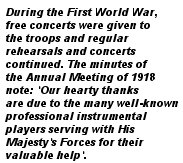
At the society's debut concert on March 5th 1841, Richard Bray, a well-known Norwich violinist, was both leader and conductor. The orchestra consisted of fifteen string players, a small woodwind section and a piano. Mozart, Beethoven, Handel and Rossini were in the substantial programme of fourteen items. Other composers represented were de Beriot, Clifton, Rooke, Kalkbrenner, AnDriozzi, Paer, Stevens and John Parry, every one of whom was composing in the early or mid-19th century but is largely forgotten in the 20th. 
After the death of Frank, his son Frank William Bianchi Noverre continued the family tradition with the Philharmonic and Triennial. The 1880s brought the formation of a ladies' Orchestral Society which had a vogue for some years. It was in 'Noverre's Assembly Rooms' that the society gave a Centenary Concert in 1901, the first to be conducted by Dr Frank Bates. He had succeeded Dr Horace Hill who was preceded by Dr F.E. Gladstone, Norwich Cathedral Organist, who had followed James Harcourt, who took over from Richard Bray, the original conductor, and held the post for thirty-five years. From the turn of the century the main place for the society's concerts became St AnDrew's Hall with a few in the CatheDral and occasionally at the Theatre Royal. 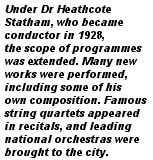
Dr Bates conducted the 200th concert in 1924 when Myra Hess was the soloist in Beethoven's Fourth Piano Concerto. He retired in 1928 to be succeeded by Dr Heathcote Statham who had just been appointed the CatheDral organist. In 1930 the Philharmonic Chorus was formed as a separate entity. Until then choral works were given in collaboration with the Norwich Choral Society. The 300th concert in 1947 brought a performance of Handel's Messiah with Dr Statham conducting and Peter Pears among the soloists. During Dr Statham's reign of thirty-two years, the scope of programmes was extended and many works were performed, including some of his own composition. After he retired, Sydney Gould, the orchestra's leader, was acting conductor for three seasons, sharing the duties with a number of visiting conductors. |
| Then in 1963, Antony Hopkins as conductor began a
partnership with the society that lasted for seven highly successful
seasons.
Two conductors, Julian Webb (orchestra) and Michael Nicholas (chorus) were appointed in 1971 and 1972 respectively and they are the first to share the conductorship in this way. 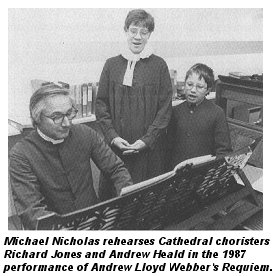
Under their guidance the society raised its standards still higher and it frequently won compliments from the distinguished soloists it brought to Norwich and from other visiting musicians. 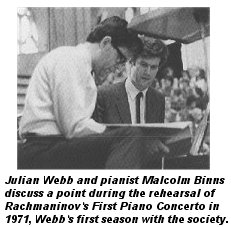
In 1891, the society's 50th year, William Heaver wrote a monograph saying there were fewer enthusiastic amateurs than there were in the early half of the century. In 1991, the 150th year, no one could complain of such a shortage. Footnote: Both David and Matt continue to maintain the high musical standards of their predecessors, bringing pleasure to performers and audiences alike. |